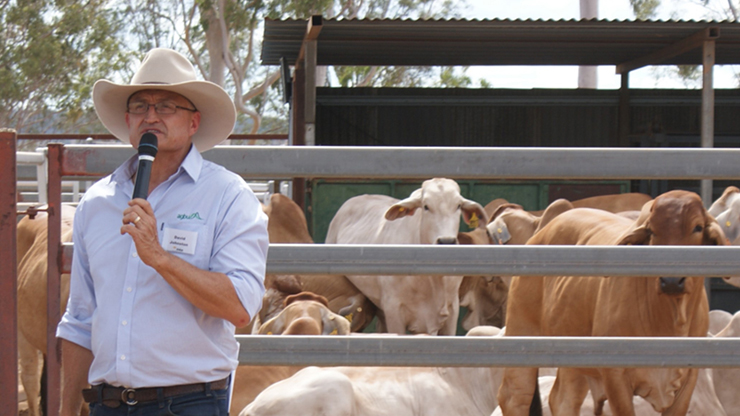 Dr David Johnston presenting on repronomics results at a BeefUp Forum in Mundubbera, Queensland.
Dr David Johnston presenting on repronomics results at a BeefUp Forum in Mundubbera, Queensland.
Reducing purchasing risk and increasing profitability
Dr David Johnston has a goal for every bull sold across Australia to be backed by an estimated breeding value (EBV).
As Principal Scientist at the University of New England’s Animal Genetics and Breeding Unit (AGBU), he sees this as how the beef industry’s genetic analysis powerhouse – BREEDPLAN – can reach its peak potential and deliver the game-changing genetic gains it was built for.
This is where repronomics research comes into play.
Playing the long game
Repronomics research has been ticking away for almost 15 years, to improve reproduction in the northern beef herd.
To date, genetic data from 12,000 calves – sired by 400 bulls from key tropical breeds – has been recorded and analysed for 20–30 traits.
The latest MLA-supported project aims to extend the focus to enable northern cattle producers to leverage both within-breed and, importantly, across-breed genomic selection for a large number of production, reproduction and welfare traits.
This functionality will be added to BREEDPLAN in the coming years.
“We want producers to be able to compare EBVs across breeds because currently, a +20 for 200-day weight in a Brahman is not comparable with a +20 in a Santa Gertrudis,” David said.
Female reproduction hurdles
Honing female reproduction has been a challenge – particularly for northern cattle producers with large, widely dispersed herds.
The days to calving EBV has been the go-to trait for many breeders. Despite being a useful tool, its low heritability, combined with lower levels of recording, has spurred researchers to look further afield into other reproduction traits to help accelerate genetic gain among tropical breeds.
Researchers decided it was time to shift the focus.
Quicker gains
There are two female reproductive traits closely linked to a cow’s ability to maintain the sought-after yearly calving cycle and lifetime reproductive performance:
- heifer age of puberty (the age when the first corpus luteum is observed via ultrasound scanning) and
- lactation anoestrous interval (the time after calving until first-calf cows resume cycling).
“Heifer age of puberty, in particular, is highly heritable, which makes it easier to accelerate reproductive improvements in a herd,” David said.
“The shorter the lactation anoestrous interval, the more likely the cow will get back in calf within 80 days of calving – which is essential to establish and maintain an annual calving system.”
Targeting bulls
David recollects times past when many sales catalogues would list bulls without EBVs.
“These days, several sales mandate the provision of genetic information on sale animals. If genotyped with a high-density DNA chip, the profile can be put into the BREEDPLAN genomic evaluations to generate EBVs on these sale bulls. This gives producers greater access to the genetics they’re introducing into their herds,” David said.
In preparation for the upcoming spring bull sales, David expects to see a sharp increase in the number of bull tissue samples sent away for DNA analysis. This information will be fed back into BREEDPLAN and be ready in time for those keen to develop more targeted breeding strategies over the coming year.
Accuracy reduces risks
Repronomics research continues to deliver increased accuracy in many traits – for example Brahman days to calving EBV accuracy has improved by 23%.
David encourages producers to make use of these tools for genetic gain and avoid buying bulls based on visual inspection alone.
“Without an EBV you’re taking a chance that you’ll get a good bull. If you buy a genetically undesirable bull, it could take years to breed his genes out of your herd,” he said.
“EBVs remove a lot of this risk and hopefully you’ll buy a bull with the right combination of traits for your environment and market. It’s about being able to predict the genetic merit and ultimately increase profitability.”
Nature and nurture
Visual inspection can’t identify many of the traits associated with profitability such as calving ease or female reproduction. Growth traits should be genetically selected, as visual inspection only gives potential buyers part of the bigger picture of an animal’s potential.
“You might be able to see growth or muscling but they could also be significantly influenced by the environment, such as high levels of feeding,” David said.
“Producers should focus on genetics and management strategies in tandem. If you don’t provide an adequate environment, you won’t see the benefits of the genetics you’ve purchased.
“Nutrition, weaning, supplementation and health treatments all contribute to an animal’s expression of its genetics. In many cases, for marbling genetics to be fully realised, the animal will need to be sent to a feedlot.”
Three steps to get set for bull salesCollect catalogues and make a list of bulls whose EBVs:
When inspecting bulls, consider:
View the free ‘How to shop for a high-performing sire’ guide |
Repronomics research - Accelerating genetic gain across the red meat industryEnabling genetic improvement of reproduction in tropical beef cattle
Building and delivering effective genomic selection for northern Australian cattle
Northern Beef Information Nucleus (Spyglass)
Northern Beef Information Nucleus (Brian Pastures)
Industry-driven reference population for northern multi-breed genomic selection
|
Northern Genetics Field Day
Attend the Northern Genetics Field Day at Spyglass Beef Research Station in Charters Towers, Queensland on 27 August. The event will showcase the significant investments in genetics within Northern Australia.
More information: Northern Genetics Field Day



